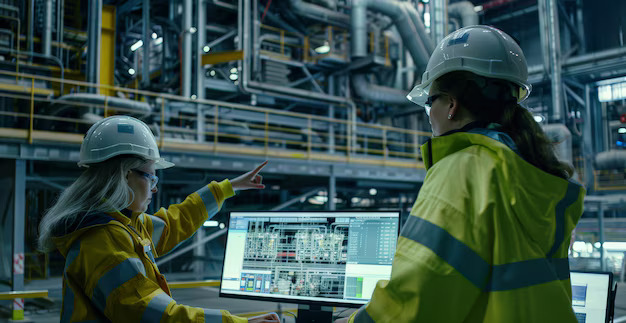An industrial gas plant specializes in producing, storing, and distributing various types of gases essential for industrial applications. These plants serve a wide array of industries, including healthcare, manufacturing, metallurgy, food processing, and energy. They typically categorize the gases they produce into atmospheric gases (oxygen, nitrogen, argon), process gases (hydrogen, carbon monoxide, syngas), and specialty gases.
Understanding the Functionality of an Industrial Gas Plant
At its core, an industrial gas plant is engineered to separate and purify gases from the atmosphere or chemical feedstocks using sophisticated technologies. The two primary sources for gas production include:
-
Air Separation Units (ASUs) for atmospheric gases
-
Steam Methane Reforming (SMR) and Partial Oxidation (POX) for hydrogen and syngas
These processes rely on precise thermodynamic, cryogenic, or chemical reactions to yield high-purity gases suitable for industrial use.
Visit this Page for More Information: Start a Business in Industrial Gases Industry
Types of Gases Produced in an Industrial Gas Plant
1. Oxygen (O?)
Used extensively in medical facilities, steel production, welding, and wastewater treatment. Industrial oxygen is produced via cryogenic distillation of air or pressure swing adsorption (PSA) methods.
2. Nitrogen (N?)
Vital in food packaging, electronics manufacturing, and as an inert atmosphere in chemical processes. Nitrogen is commonly produced through ASUs or membrane separation technologies.
3. Argon (Ar)
Extracted during the oxygen and nitrogen separation process, argon is crucial in arc welding, semiconductor manufacturing, and as a shielding gas.
4. Hydrogen (H?)
A key component in ammonia production, petroleum refining, and as a clean energy source. Produced via steam methane reforming, hydrogen is stored under high pressure or as a cryogenic liquid.
5. Carbon Dioxide (CO?)
Collected as a byproduct in hydrogen plants or fermentation processes, CO? is used in carbonated beverages, fire suppression systems, and enhanced oil recovery.
6. Specialty Gases
Including helium, acetylene, xenon, neon, and krypton, these gases are tailored for niche applications in aerospace, medical imaging, and lighting.
Key Components of an Industrial Gas Plant
An effective industrial gas plant integrates various units, each responsible for a critical stage in gas production:
-
Air Compression Systems – Draw and compress atmospheric air for separation
-
Pre-Cooling Units – Reduce air temperature before processing
-
Molecular Sieve Units – Eliminate moisture and CO? from air feed
-
Cryogenic Distillation Columns – Separate air into oxygen, nitrogen, and argon
-
Storage Vessels – Hold gases in liquid or compressed form
-
Distribution Networks – Pipelines, cylinders, or tankers used for delivery
Each component must be meticulously designed to ensure operational efficiency, safety, and product purity.
Related Feasibility Study Reports: Industrial Gases
Technologies Used in Industrial Gas Plants
Cryogenic Distillation
This time-tested technique cools air to extremely low temperatures until it liquefies. Operators then separate the liquids based on their boiling points. This method produces large volumes of high-purity gases efficiently.
Pressure Swing Adsorption (PSA)
This non-cryogenic method separates gases using adsorbent materials like zeolites. Small to medium-sized plants commonly use PSA systems to generate oxygen or nitrogen.
Membrane Separation
Utilizes selective permeable membranes to separate gases. Efficient for nitrogen production and certain specialty gas mixtures.
Steam Methane Reforming (SMR)
Involves reacting methane with steam to produce hydrogen. This is the most prevalent technology for large-scale hydrogen production in refineries and chemical industries.
Applications of Gases from Industrial Gas Plants
Healthcare Industry
Medical-grade oxygen supports life-saving treatments in hospitals, and medical professionals use nitrous oxide as an anesthetic. Pharmaceutical manufacturers rely on high-purity nitrogen in their production environments.
Metallurgy and Steel Industry
Oxygen aids in blast furnace operations and enhances combustion, improving the efficiency of steel manufacturing.
Chemical and Petrochemical Industries
Hydrogen is integral to hydrocracking and desulfurization processes in refineries. Nitrogen serves as a blanket gas for chemical storage.
Food and Beverage Sector
Carbon dioxide is used in carbonation, while nitrogen preserves packaged foods by displacing oxygen and moisture.
Electronics and Semiconductor Industry
Ultra-high purity gases like argon, nitrogen, and hydrogen are used in wafer fabrication and device assembly processes.
Safety and Environmental Considerations
Operating an industrial gas plant involves handling gases under high pressure and cryogenic temperatures. Strict safety protocols must be in place to manage risks such as leaks, explosions, and frostbite. These include:
-
Gas Leak Detection Systems
-
Explosion-Proof Equipment
-
Regular Maintenance and Inspections
-
Personnel Training and PPE Usage
From an environmental standpoint, many industrial gas plants are transitioning to green hydrogen and carbon capture solutions to reduce their carbon footprint and align with global sustainability goals.
Read our Book Here: The Complete Book on Industrial Gases
Industrial Gas Plant Operations and Maintenance
Efficient operation of an industrial gas plant hinges on:
-
Advanced Monitoring Systems – SCADA and PLC systems for real-time control
-
Predictive Maintenance – AI and IoT for minimizing unplanned downtimes
-
Energy Optimization – Reducing electricity consumption in compressors and refrigeration cycles
Routine calibration, inspection, and component replacement ensure the longevity and safety of plant infrastructure.
Future Trends in Industrial Gas Plants
Industrial gas plants are shifting their focus toward sustainability, automation, and decentralization. They are adopting key trends such as:
-
Green Hydrogen Production using electrolysis powered by renewable energy
-
Mini and Modular Gas Plants for localized production
-
Digital Twin Technology for real-time simulation and control
-
Integration with Renewable Energy Sources for lower carbon emissions
Investments in R&D are accelerating to meet the demands of clean energy transitions and increasing industrialization globally.
Conclusion
An industrial gas plant is the heartbeat of modern industry, supplying vital gases that drive efficiency, innovation, and productivity. From cryogenic air separation to cutting-edge hydrogen production, these facilities are engineering marvels built to meet stringent quality, safety, and sustainability standards.




